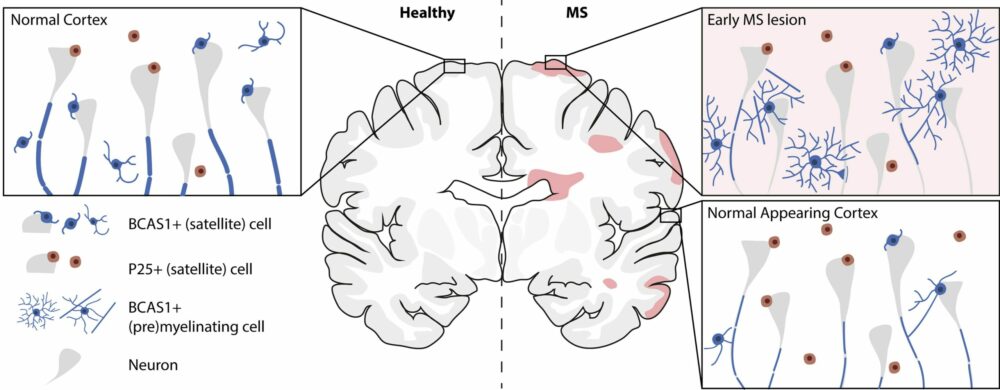BCAS1+ oligodendrocytes enable efficient cortical remyelination in multiple sclerosis
Other (17)
Background:
Remyelination is a vital regenerative process in the central nervous system (CNS), restoring nerve function and providing essential support to neurons. In multiple sclerosis (MS), a disease characterized by demyelination, this repair mechanism is crucial to prevent lasting neurological damage. Interestingly, remyelination appears more efficient in the brain’s cortex (grey matter) than in the white matter. The study focuses on Brain-enriched myelin-associated protein 1 (BCAS1), a marker identifying oligodendrocyte lineage cells actively forming myelin during development and regeneration. Notably, BCAS1-positive (BCAS1+) oligodendrocytes are maintained at high densities in the cortex throughout life.
Key Findings:
- Activation of BCAS1+ Oligodendrocytes Post-Demyelination:
- In both human MS patients and mouse models, BCAS1+ oligodendrocytes transition from a quiescent state to an active, myelin-forming morphology following demyelination. They co-express myelin-associated glycoprotein (MAG), essential for establishing contact with axons, indicating their direct involvement in remyelination.
- Early Response Amidst Inflammation:
- Activated BCAS1+ oligodendrocytes are present at early stages of experimental demyelination, even during ongoing inflammation. In human tissues, their activation correlates with the density of myeloid cells, suggesting these oligodendrocytes participate in the immediate regenerative response to demyelination.
- Shift in Oligodendrocyte Populations in Chronic MS:
- In the normal-appearing cortex of chronic MS patients, there’s a shift from quiescent BCAS1+ oligodendrocytes to mature, myelin-maintaining oligodendrocytes. This suggests that over time, the differentiation of these cells occurs with limited replenishment, potentially contributing to remyelination failure observed in chronic MS.
- Role of Perineuronal Satellite Oligodendrocytes:
- Some perineuronal satellite oligodendrocytes, located near neurons, are BCAS1+. These cells contribute to remyelination in both human and experimental cortical demyelination, highlighting their significance in the repair process.
Implications:
- Rapid Remyelination:
- The presence of pre-differentiated BCAS1+ oligodendrocytes in the adult cortex enables a swift response to demyelinating events, facilitating immediate myelin regeneration.
- Remyelination Failure in Chronic MS:
- The limited replenishment of BCAS1+ oligodendrocytes in chronic MS may lead to remyelination failure, emphasizing the need for therapeutic strategies to support the maintenance and regeneration of these cells.
Conclusion:
This study provides evidence that BCAS1+ cells in the adult cortex are a population of pre-differentiated oligodendrocytes capable of rapidly initiating remyelination after demyelination. However, in chronic MS, the limited replenishment of these cells may contribute to remyelination failure. Understanding the dynamics of BCAS1+ oligodendrocytes offers valuable insights into potential therapeutic targets to enhance remyelination in demyelinating diseases like MS.
For a comprehensive understanding, you can access the full article here: BCAS1-positive oligodendrocytes enable efficient cortical remyelination in multiple sclerosis.
TRR 274 Project leaders contributing to this project: Stefan Nessler (B02), Mikael Simons (A06, B01, Z02), Christine Stadelmann (B01, B03, Z01)





